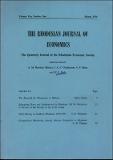| dc.contributor.author | Gupta, Desh | |
| dc.coverage.spatial | Malawi. | en |
| dc.date.accessioned | 2015-09-11T13:34:00Z | |
| dc.date.available | 2015-09-11T13:34:00Z | |
| dc.date.issued | 1976-03 | |
| dc.identifier.citation | Gupta, D. (1976) The Demand for Manpower in Malawi: Economic Growth, Employment Opportunities and the Utilization of Manpower. The Rhodesia Journal of Economics (RJE), vol. 10, no. 1, (pp.1-13). UR (now UZ), Salisbury (now Harare): RES. | en |
| dc.identifier.uri | https://opendocs.ids.ac.uk/opendocs/handle/20.500.12413/6950 | |
| dc.description | A RJE article on Malawi's manpower needs to sustain its economic growth in the mid 1970's. | en |
| dc.description.abstract | It is a truism to say that people with higher education earn more on the average than those with less education, at least if the same age profile is being considered. This is even more so in the case of developing countries, particularly in those ex-colonial territories, which have recently attained independence. There are several reasons for this. The basic one is that of relative scarcity i.e. those with higher education are in relatively greater demand in relation to their supply than those with lower education. We are all aware that if supply increases more rapidly than demand for any given type of labour then there will be a relative fall in its earnings, other things being equal. So the basic point to bear in mind in explaining the relative earnings is the different historical rates of demand for and growth of different types of labourforce. In the case of open economies i.e. those which are willing to import manpower to meet basic deficiencies, the international market earnings do influence the earnings level of the local labour force. But often institutional mechanisms are devised, and sometimes quite successfully, to ward off the upward spiralling effect of rising international wages on domestic wage levels. Thus apart from the fundamental supply and demand relationship, there are the institutional factors, which determine the basic wage levels and the changes in these. To take an example minimum wages were increased between 1954 and 1966 in Malawi, but until late 1974 there was no change in these, (see Table One), despite increases in price level. Thus institutional factors pushed up the minimum wage between 1953 and 1966, but played no part in changing them since; except in so far as the more rigorous wages and salaries restraint policy implemented since 1970 may have had a depressing effect on these. | en |
| dc.language.iso | en | en |
| dc.publisher | Rhodesian Economic Society. (RES) University of Rhodesia (UR) (now University of Zimbabwe.) (UZ.) | en |
| dc.rights.uri | http://creativecommons.org/licenses/by-nc-nd/3.0/ | en |
| dc.subject | Economic Development | en |
| dc.subject | Work and Labour | en |
| dc.title | The Demand for Manpower in Malawi: Economic Growth, Employment Opportunities and the Utilization of Manpower | en |
| dc.title.alternative | The Demand for Manpower in Malawi. | en |
| dc.type | Article | en |
| dc.rights.holder | University of Zimbabwe (UZ) (formerly University College of Rhodesia) | en |


